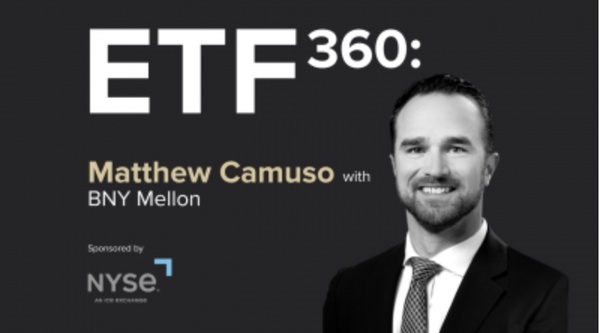For this episode of “ETF 360,” VettaFi’s head of research, Todd Rosenbluth, spoke with Matt Camuso, strategist at BNY Mellon, about BNY Mellon’s entrance into the ETF space two years ago and a variety of the company’s products, including its concentrated, active options within international equities.
BNY Mellon just recently hit its second anniversary since its first ETF launch. Camuso explained that the company’s ETFs have been well received by many client types, from institutional investors to financial advisors and more.
“Back in 2020, when we launched our ETF platform, the idea was to bring the scale and the efficiency of BNY Mellon as an end-to-end ETF provider to investors,” Camuso said. “If you look at our enterprise, we have business lines that touch really every part of the ETF ecosystem, from asset servicing to primary and secondary market services, to sub-advisory and now as an ETF issuer.”
This streamlined approach as an end-to-end provider gives BNY Mellon’s clients two advantages: cost savings — particularly within beta portions of a portfolio — and also investor access to BNY Mellon’s investment specialist firms through its ETFs.
On the cost savings side, BNY Mellon offers eight different indexed ETFs with a total of $1.2 billion in AUM, and two of those are industry-first zero-fee ETFs, the BNY Mellon US Large Cap Core Equity ETF (BKLC) and the BNY Mellon Core Bond ETF (BKAG).
“In most client portfolios, those are the two biggest buckets, if you will, from an allocation perspective, so offering zero basis point products allows our clients to take down the overall cost of the portfolio,” Camuso explained.
Content continues below advertisement
Addressing Client Concerns in a Challenging Market
When talking to clients in the challenging markets of 2022, BNY Mellon has found that the most common question it receives is how to blend diversifying, highly concentrated active managers with benchmark exposures, something that BNY Mellon’s six actively managed ETFs can provide. With growing interest in how to incorporate its funds within model portfolios, Camuso believes that the pipeline for BNY Mellon is robust.
“It’s really looking at certain asset classes where active management can provide that diversification, whether that be an inflation hedge, whether that be to take down volatility in sectors,” Camuso said.
A specific area where these opportunities arise is within developed international equities, accessible through the dual use of a broad-based fund like the BNY Mellon International Equity ETF (BKIE) alongside the BNY Mellon Concentrated International ETF (BKCI), a fund with only 25–30 securities.
BKCI is managed by Walter Scott, a firm out of Scotland with $94 billion in AUM, and utilizes a strategy that screens for high-quality companies that exhibit a history of profitable growth across varying market environments.
“Really, what they’re trying to do is find companies with very strong balance sheets that have attractive growth prospects that are driven not by cyclical growth cycles but for long-term growth cycles. What that leads to is a basket of companies that actually have lower volatility, as history shows us in the benchmark,” Camuso discussed.
For more ETF 360 videos, visit our ETF 360 Channel.

